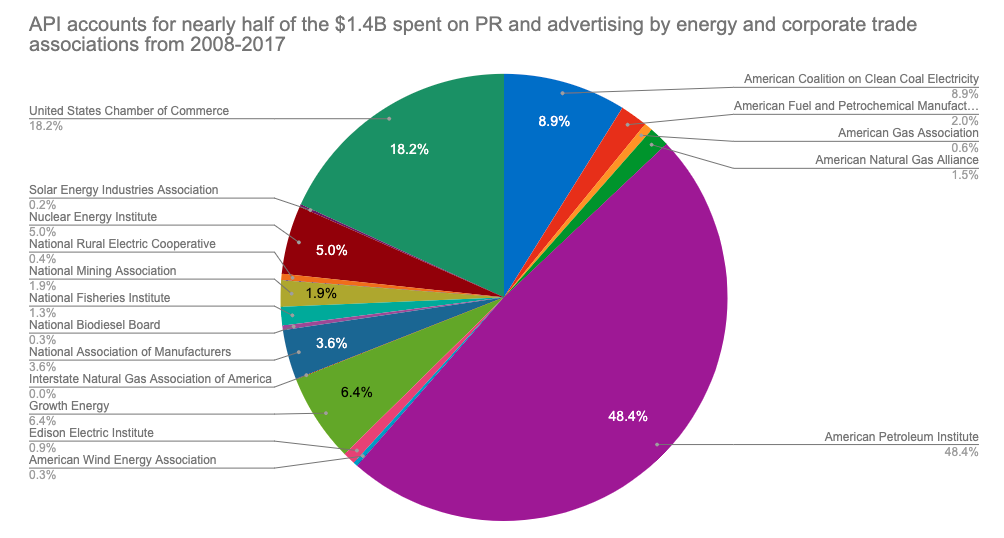In early March 2019, the Climate Investigations Center (CIC) launched its Trade Associations and the Public Relations Industry report, which revealed the almost $1.4 billion energy and business trade associations spent over the past decade on advertising, communications, and advocacy via contracts with public relations (PR) companies.
Since the publication of the report, CIC’s Kert Davies has been interviewed by online media outlets and podcasts discussing which PR firms were contracted, the various campaigns spawned from these connections, and the impacts these campaigns have on the public and lawmakers.
HuffPost
In a HuffPost article titled Big Business Spent $1.4 Billion On PR, Advertising Over The Last Decade, Chris D’Angelo wrote about CIC’s findings on trade associations and their public relations contracts. Additionally, D’Angelo interviewed Robert Brulle, an environmental sociologist at Brown University who has tracked corporate spending and climate change denial groups. Regarding trade association PR contracts, Brulle says, “I don’t think you can understand the opposition to climate action unless you take this massive amount of activity into account.” Brulle called these PR campaigns the “sinews of the political operations and the cultural operations surrounding climate politics.”
Drilled Podcast
“In a lot of ways, PR firms have been sort of the linchpin of the fossil fuel industry’s plan for a long, long time.”
The true crime podcast, Drilled, hosted Davies on an episode titled, Big Oil Is Ramping Up PR Spending and Oil Production, which focused on the relationship between the fossil fuel industry and public relations firms. The episode covered both CIC’s trade association PR investigation as well as a report published by Influence Map.
Host Amy Westervelt described PR firms as being “the linchpin of the fossil fuel industry’s plan for a long, long time,” highlighting their extensive use by trade associations that represent the corporate interests of their membership. These trade associations allow member companies to push their political and anti-environmental agendas without a direct connection to their brand which might tarnish their reputation.
Westervelt highlighted trade associations such as the American Petroleum Institute (API), the National Association of Manufacturers (NAM), and the US Chamber of Commerce as some of the biggest offenders. During the interview, Davies explained that the visible PR campaigns are part of larger goals and targets that have been “agreed upon by the members of that trade association” and are a “window into their political game.” He notes that this tactic includes “very little overt climate denial” and instead is about “laying the groundwork for the campaigns that are against policies on climate change.” For instance, by “making fracking look good” people may begin to “question these policies like the Green New Deal,” Davies says.
The Real News Network
Davies was also recently interviewed on the Real News Network where he outlined the origins of CIC’s 2019 trade association PR investigation, showcased the report’s findings, and discussed the purpose of trade association campaigns.
As discussed on the show, the money spent on PR contracts by renewable energy associations and fossil fuel associations was a major finding of CIC’s investigation. Of the almost $1.4 billion spent by trade associations in the past decade, only $98.4 million of it (7%) was spent by renewable energy associations. In his interview, Davies elaborated, stating:
…it turns out that if you add all of [the renewable energy trade association PR contracts] up, including the ones that do biofuels and ethanol… they are a fraction of the total spending… API alone is six times the total spending of all the renewable energy associations combined.
API alone spent over six times more than the renewable energy trade associations we analyzed.
Davies also explains that this 2019 report was a continuation of a 2014 CIC investigation, which started with a survey to PR firms asking questions about their internal climate action plans, carbon tracking initiatives, and any client projects focused on climate change issues. As Davies explained, “Turns out, nobody had ever asked the PR companies these questions before, but we got some very interesting responses, including the biggest company, Edelman, who accidentally sent me an email saying ‘there are only wrong answers here, don’t respond.’”

Dharna Noor,
The Intercept
…companies are “using stories that appear to be part of a journalistic publication, but are actually paid for by advertisers in attempt to improve an image…”
In early April 2019, the Intercept published an article by Sharon Lerner titled, How the Media Launders Fossil Fuel Industry Propaganda Through Branded Content. The Intercept article warns against the rise of”native advertising”, which is a form of advertising where an ad is written in article form and published on credible news sites to look like an article.
Lerner explains that fossil fuel and other companies are “using stories that appear to be part of a journalistic publication, but are actually paid for by advertisers in
Click here to read CIC’s full Trade Associations and the Public Relations Industry report

